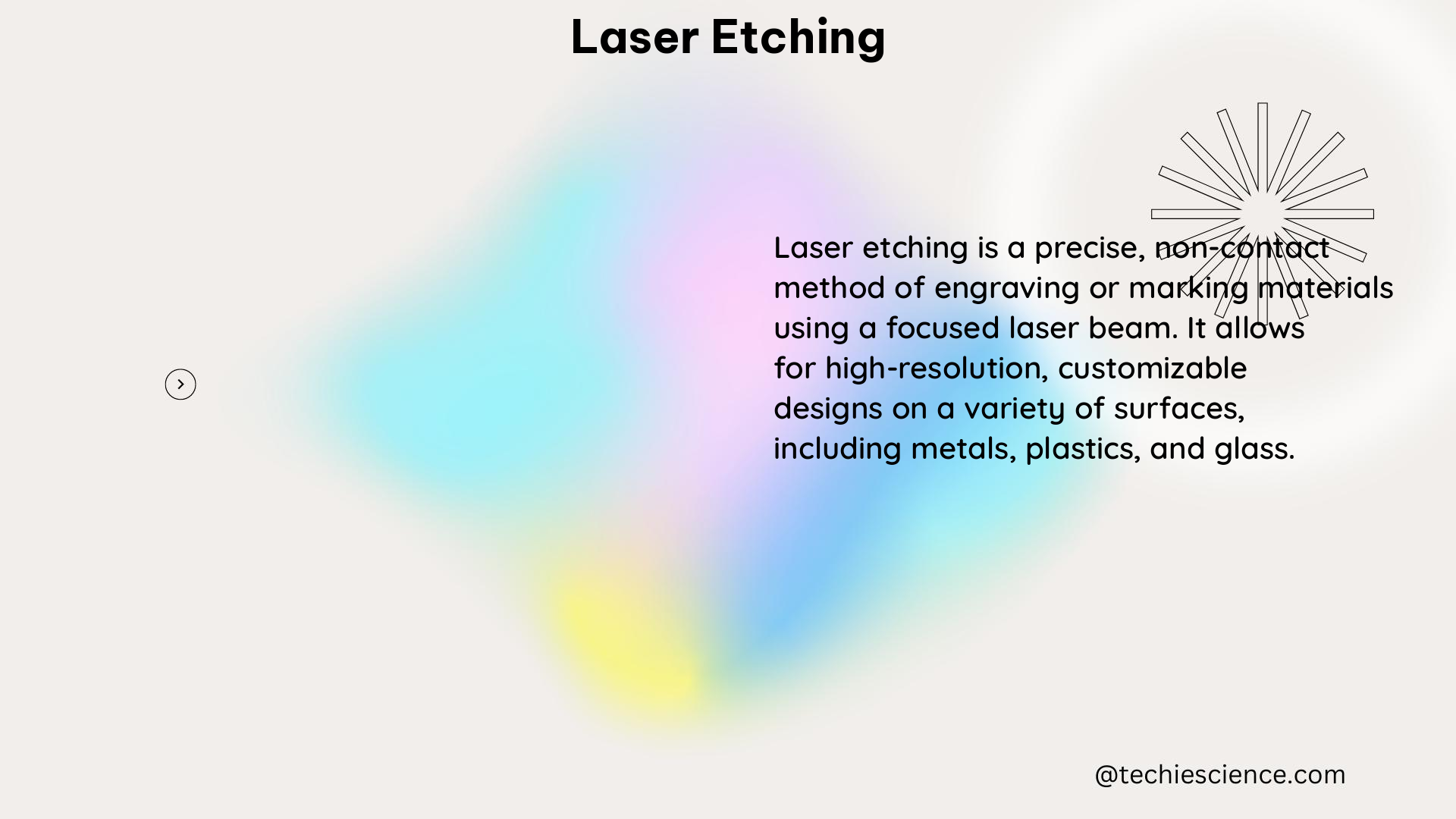Laser etching is a highly precise and versatile technique that allows for the creation of permanent markings on a wide range of materials, including metals, plastics, and ceramics. By precisely controlling the energy delivered by a laser beam, this process can produce intricate designs, serial numbers, barcodes, and logos with exceptional accuracy and durability. This comprehensive guide will delve into the technical details of laser etching, providing science students with a hands-on playbook to master this advanced manufacturing process.
Understanding the Fundamentals of Laser Etching
Laser etching is a non-contact, subtractive manufacturing process that utilizes a focused laser beam to selectively remove material from the surface of a workpiece. The laser beam, typically generated by a CO2 or fiber laser, delivers a high amount of energy to a small, targeted area, causing the material to melt and vaporize. This localized melting and expansion of the material results in the creation of permanent markings on the surface.
The key parameters that govern the laser etching process are:
-
Laser Power: The power of the laser beam, typically measured in watts (W), determines the amount of energy delivered to the material. Higher laser power can result in deeper and more pronounced etchings.
-
Pulse Duration: The duration of each laser pulse, measured in microseconds (μs), affects the depth and width of the etching. Shorter pulses can create finer, more detailed markings.
-
Pulse Frequency: The number of laser pulses per second, measured in hertz (Hz), influences the speed and quality of the etching process. Higher pulse frequencies can lead to faster processing times.
-
Beam Spot Size: The diameter of the focused laser beam, typically measured in micrometers (μm), determines the resolution and precision of the etching. Smaller beam spot sizes can produce more detailed markings.
-
Scan Speed: The speed at which the laser beam moves across the material’s surface, measured in millimeters per second (mm/s), affects the depth and quality of the etching. Slower scan speeds can result in deeper and more uniform markings.
Controlling the Etching Process: Line Interval and DPI

The size and appearance of the markings created through laser etching are primarily determined by two key settings: line interval and DPI (dots per inch).
Line Interval
The line interval, measured in micrometers (μm), refers to the distance between the individual lines or passes of the laser beam. A smaller line interval results in a higher density of lines, leading to a more uniform and continuous appearance of the etching.
The line interval can be calculated using the following formula:
Line Interval = Beam Spot Size / (DPI / 25.4)
Where:
– Beam Spot Size is the diameter of the focused laser beam, measured in micrometers (μm)
– DPI is the desired dots per inch of the etching
DPI (Dots per Inch)
The DPI setting determines the number of individual dots or pixels that make up the etching per inch of the material’s surface. A higher DPI value results in a higher resolution and more detailed markings, but it also requires a smaller line interval to avoid overlapping of the laser passes.
The relationship between line interval and DPI can be expressed as:
DPI = 25.4 / Line Interval
Where:
– Line Interval is the distance between the individual lines of the etching, measured in micrometers (μm)
– 25.4 is the conversion factor from micrometers to inches
It is important to find the optimal balance between line interval and DPI to achieve the desired quality and appearance of the etching without causing overburning or damage to the material.
Laser Beam Characteristics and Energy Delivery
The laser beam used in the etching process is a critical component that determines the quality and precision of the markings. Pulsed lasers, such as CO2 or fiber lasers, are commonly used in laser etching applications due to their ability to deliver high-energy pulses with precise control.
Pulsed Laser Characteristics
- Pulse Energy: The amount of energy contained in each laser pulse, typically measured in millijoules (mJ).
- Pulse Duration: The duration of each laser pulse, typically in the range of microseconds (μs) to nanoseconds (ns).
- Pulse Frequency: The number of laser pulses per second, measured in hertz (Hz).
- Peak Power: The maximum power of the laser pulse, calculated by dividing the pulse energy by the pulse duration, typically in the range of kilowatts (kW) to megawatts (MW).
The energy delivered by each laser pulse is absorbed by the material, causing it to heat up and melt. This localized melting and expansion of the material result in the creation of permanent markings on the surface.
Energy Absorption and Material Interaction
The interaction between the laser beam and the material being etched is a complex process that involves several physical phenomena, including:
-
Optical Absorption: The material’s ability to absorb the laser energy, which is influenced by factors such as the wavelength of the laser, the material’s optical properties, and the surface condition.
-
Thermal Conduction: The transfer of heat within the material, which can affect the depth and width of the etching.
-
Phase Transitions: The changes in the material’s physical state, such as melting and vaporization, which occur due to the high-energy input from the laser.
-
Plasma Formation: The ionization of the material’s surface, which can occur at high laser intensities and can influence the etching process.
Understanding these material-laser interactions is crucial for optimizing the laser etching process and achieving the desired results.
Laser Etching Techniques and Applications
Laser etching can be employed in a wide range of applications, from industrial manufacturing to consumer products. Some of the common techniques and applications include:
Techniques
- Raster Scanning: The laser beam is scanned across the material’s surface in a raster pattern, creating a series of parallel lines to form the desired marking.
- Vector Scanning: The laser beam follows a predefined vector path, allowing for the creation of more complex designs and shapes.
- Mask Projection: A mask or stencil is used to selectively expose the material to the laser beam, enabling the creation of multiple markings simultaneously.
Applications
- Industrial Marking: Laser etching is widely used for marking serial numbers, barcodes, and other identification codes on metal parts, tools, and equipment.
- Product Branding: Logos, graphics, and other branding elements can be permanently etched onto consumer products, such as electronics, jewelry, and sporting goods.
- Medical Device Marking: Laser etching is used to mark medical devices, implants, and surgical instruments with unique identifiers for traceability and patient safety.
- Art and Engraving: The precision and control of laser etching make it a popular technique for creating intricate designs, patterns, and engravings on a variety of materials.
- Semiconductor Packaging: Laser etching is employed in the semiconductor industry for marking and identification of integrated circuits, wafers, and other electronic components.
Emissions and Environmental Considerations
While laser etching is a highly efficient and precise manufacturing process, it is important to consider the potential environmental impact, particularly the emissions generated during the process.
A study on the characterization of emissions from carbon dioxide laser cutting activities found that there was a significant increase in total particulate concentrations during the post-background period after the laser cutting had been completed and the fume exhaust was turned off. The concentration of each method was an average of two laser cutting trials, with all six individual trial data presented in the study.
An ANOVA statistical test was used to determine that there was a significant difference between the total concentration means of each phase of laser cutting activities, with a follow-up t-test determining that there were only significant differences between the total background and post-background concentrations in Methods 2 and 3.
To mitigate the potential environmental impact of laser etching, it is essential to implement appropriate engineering controls, such as effective fume extraction systems and proper ventilation, to capture and contain the emissions generated during the process. Additionally, regular monitoring and testing of air quality in the work environment can help ensure compliance with relevant environmental regulations and safeguard the health and safety of workers.
Conclusion
Laser etching is a highly versatile and precise manufacturing process that allows for the creation of permanent markings on a wide range of materials. By understanding the fundamental principles of laser-material interactions, the importance of line interval and DPI settings, and the potential environmental considerations, science students can develop a comprehensive understanding of this advanced technique.
This hands-on playbook has provided a detailed overview of the technical aspects of laser etching, equipping you with the knowledge and tools necessary to effectively apply this process in various scientific and industrial applications. As you continue to explore and experiment with laser etching, remember to prioritize safety, environmental sustainability, and the pursuit of innovative solutions that push the boundaries of what is possible.
References
- Understanding line interval/DPI for engraving – Community Laser Talk. (2020-03-12). Retrieved from https://forum.lightburnsoftware.com/t/understanding-line-interval-dpi-for-engraving/13110
- Characterization of Emissions from Carbon Dioxide Laser Cutting Activities. (2023-06-22). Retrieved from https://www.ncbi.nlm.nih.gov/pmc/articles/PMC10369487/
- Laser Etching: Everything You Need to Know – Laserax. (2020-08-04). Retrieved from https://www.laserax.com/blog/laser-etching
- Laser Etching Fundamentals: A Comprehensive Guide. (2022-09-15). Retrieved from https://www.lasermech.com/blog/laser-etching-fundamentals
- Laser Etching Techniques and Applications. (2021-11-30). Retrieved from https://www.troteclaser.com/en/knowledge-base/laser-etching-techniques-and-applications/

Hi, I am Sanchari Chakraborty. I have done Master’s in Electronics.
I always like to explore new inventions in the field of Electronics.
I am an eager learner, currently invested in the field of Applied Optics and Photonics. I am also an active member of SPIE (International society for optics and photonics) and OSI(Optical Society of India). My articles are aimed at bringing quality science research topics to light in a simple yet informative way. Science has been evolving since time immemorial. So, I try my bit to tap into the evolution and present it to the readers.
Let’s connect through